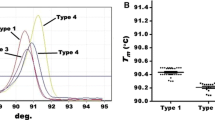Abstract
We evaluated the usefulness of dual priming oligonucleotide (DPO)-based multiplex PCR, Seeplex HBV Lami-DR assay (Seegene Institute of Life Sciences, Seoul, Korea), to detect lamivudine-resistant HBV mutants in a comparison with the use of TRUGENE™ HBV genotyping and restriction fragment mass polymorphism (RFMP). Sera from 44 chronic hepatitis B patients were analyzed for the presence of mutations at codons 180 and 204 by performing DPO-based multiplex PCR, RFMP, and TRUGENE. The overall concordance rate among the three assays was 40.9% (18/44). Concordance rates between multiplex PCR and RFMP or multiplex PCR and TRUGENE were 61.4% (27/44) and 50.0% (22/44), respectively. In ten patients, multiplex PCR identified additional mutants not found using the other two methods. DPO-based multiplex PCR is a highly sensitive method to identify minor mutant populations and could be a practical tool in the monitoring of lamivudine resistance.


Similar content being viewed by others
References
Allen M, Deslauriers M, Andrews C et al (1998) Identification and characterization of mutations in hepatitis B virus resistant to lamivudine. Lamivudine Clinical Investigation Group. Hepatology 27:1670–1677
Liaw Y, Chien R, Yeh C et al (1999) Acute exacerbation and hepatitis B virus clearance after emergence of YMDD motif mutation during lamivudine therapy. Hepatology 30:567–572
Stuyver L, Locarnini S, Lok A et al (2001) Nomenclature for antiviral-resistant human hepatitis B virus mutations in the polymerase region. Hepatology 33:751–757
Allen MI, Gauthier J, DesLauriers M et al (1999) Two sensitive PCR-based methods for detection of hepatitis B virus variants associated with reduced susceptibility to lamivudine. J Clin Microbiol 37:3338–3347
Jardi R, Buti M, Rodriguez-Frias F et al (1999) Rapid detection of lamivudine-resistant hepatitis B virus polymerase gene variants. J Virol Methods 83:181–187
Woo HY, Park H, Kim BI et al (2007) Comparison of mass spectrometric analysis and TRUGENE HBV genotyping for monitoring lamivudine resistance in chronic hepatitis B patients. Antivir Ther 12:7–13
Chun JY, Kim KJ, Hwang IT et al (2007) Dual priming oligonucleotide system for the multiplex detection of respiratory viruses and SNP genotyping of CYP2C19 gene. Nucleic Acids Res 35:e40
Kim JK, Lee HJ, Lee YJ et al (2008) Direct detection of lamivudine-resistant hepatitis B virus mutants by a multiplex PCR using dual-priming oligonucleotide primers. J Virol Methods 149:76–84
Roque-Afonso A, Ferey M, Mackiewicz V et al (2003) Monitoring the emergence of hepatitis B virus polymerase gene variants during lamivudine therapy in human immunodeficiency virus coinfected patients: performance of CLIPTM sequencing and line probe assay. Antivir Ther 8:627–634
Lampertico P, Vigano M, Manenti E et al (2005) Adefovir rapidly suppresses hepatitis B in HBeAg-negative patients developing genotypic resistance to lamivudine. Hepatology 42:1414–1419
Ohishi W, Shirakawa H, Kawakami Y et al (2004) Identification of rare polymerase variants of hepatitis B virus using a two-stage PCR with peptide nucleic acid clamping. J Med Virol 72:558–565
Krajden M, Comanor L, Rifkin O et al (1998) Assessment of hepatitis B virus DNA stability in serum by the Chiron Quantiplex branched-DNA assay. J Clin Microbiol 36:382–386
Jerome KR, Huang ML, Wald A et al (2002) Quantitative stability of DNA after extended storage of clinical specimens as determined by real-time PCR. J Clin Microbiol 40:2609–2611
Gutfreund KS, Williams M, George R et al (2000) Genotypic succession of mutations of the hepatitis B virus polymerase associated with lamivudine resistance. J Hepatol 33:469–475
Lee CH, Kim SO, Byun KS et al (2006) Predominance of hepatitis B virus YMDD mutants is prognostic of viral DNA breakthrough. Gastroenterology 130:1144–1152
Kim HS, Han KH, Ahn SH et al (2005) Evaluation of methods for monitoring drug resistance in chronic hepatitis B patients during lamivudine therapy based on mass spectrometry and reverse hybridization. Antivir Ther 10:441–449
Wen H, Li Q (2007) Real-time PCR detection of multiple lamivudine-resistant mutations with displacing probes in a single tube. J Clin Virol 38:334–340
Author information
Authors and Affiliations
Corresponding author
Rights and permissions
About this article
Cite this article
Woo, H.Y., Park, H., Kim, B.I. et al. Evaluation of dual priming oligonucleotide-based multiplex PCR for detection of HBV YMDD mutants. Arch Virol 153, 2019–2025 (2008). https://doi.org/10.1007/s00705-008-0218-3
Received:
Accepted:
Published:
Issue Date:
DOI: https://doi.org/10.1007/s00705-008-0218-3




